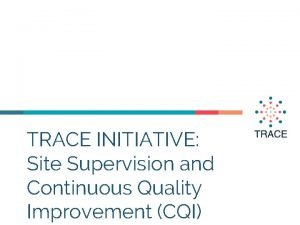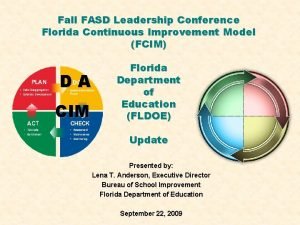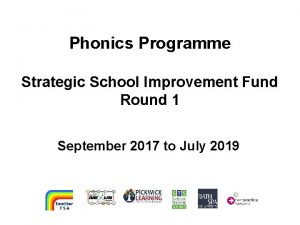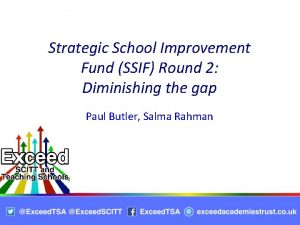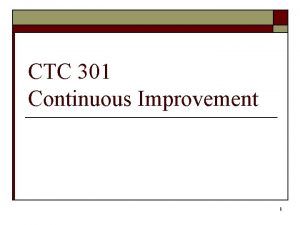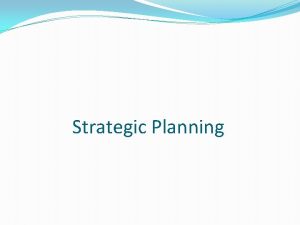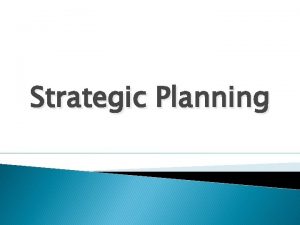Strategic Improvement Planning A Continuous Improvement Model 1










- Slides: 10

Strategic Improvement Planning A Continuous Improvement Model 1

About GSBA • The Georgia School Boards Association is a voluntary association that provides training, programs and services to the state’s 180 locally elected boards of education. For more information visit www. gsba. com 2

Plan Format Who are we? Beliefs Mission Vision Where are we now? How do we plan to get there? Initiatives Action Steps Continuous Improvement Process How will we know when we have arrived? Performance Data Financial Data Stakeholder Input SWOT Analysis Where do we want to go? Strategic Goals (or Goal Areas) Strategic Priorities Performance Objectives Measures and Targets 3

Inclusive and Transparent Continuous Improvement Process Phase 1 Who are we? Community Engagement Session Planning Team Beliefs Mission Vision SWOT Analysis Where are we now? Where do we want to go? How will we know when we have arrived? Strategic Goal Area 1 with Strategic Priorities Action Teams Performance Objective 1 with Measures & Targets Performance Objective 2 with Measures & Targets Phase 2 Action Plans Initiatives Action Steps How do we plan to get there? Board of Education District Individual Schools Strategic Goal Area 2 with Strategic Priorities Strategic Goal Area 3 with Strategic Priorities Performance Objective 3 with Measures & Targets Board/Staff Report to the Community

Education Pays EDUCATIONAL ATTAINMENT & EMPLOYMENT Unemployment Rate* 15% 10% 5% Median Wkly Earnings** (& approx. annual) July 2012 0% 0 200 600 4. 1 Bachelor’s Degree & Higher 7. 1 Some college/ Associate Degree $754 ($39, 376) 8. 7 HS Graduates, No College $659 ($34, 268) 12. 7 $1, 164 1000 ($60, 528) Less than a High School $483 Diploma ($25, 116) Source: *U. S. Bureau of Labor Statistics Table A-4. Employment status of the civilian population 25 years and over by educational attainment. **U. S. Bureau of Labor Statistics Table 5. Quartiles of usual weekly earnings of full-time wage and salary workers. 5

Unemployment Rates by County: June 2012 6 Source: Georgia Department of Labor; State average = 9. 6%

Economic Impact of Dropping Out of High School Region 1 $2. 2 billion Region 2 $1. 2 billion Region 3 $4. 2 billion Region 4 $1. 1 billion Region 5 $1. 1 billion Region 6 $1. 0 billion Region 7 $1. 1 billion Region 8 $0. 9 billion Region 9 $0. 9 billion Region 10 $2. 0 billion Region 11 $1. 0 billion Region 12 $1. 1 billion TOTAL $18 billion* How much could YOUR region benefit from this additional income currently being foregone? Source: Isley, P. & Hill, J. “Updated Economic Impact of High School Non. Completion in Georgia: 2005 Estimate, ” Georgia Southern University. April 2007. *According to GSU study, totals may not add due to rounding. 7

Community Engagement: Inclusive and Transparent • Online Survey – Link will be posted to District’s website • Community Engagement Session 8

Communicating About and Managing the Plan 9

Strategic Improvement Planning A Continuous Improvement Model 10
 Cqi action plan template
Cqi action plan template Strategic planning vs tactical planning
Strategic planning vs tactical planning Florida continuous improvement model
Florida continuous improvement model Past continuous two actions at the same time
Past continuous two actions at the same time Past simple future
Past simple future The most precise random sampling is usually done from
The most precise random sampling is usually done from Strategic workforce planning swp
Strategic workforce planning swp Strategic school improvement fund round 3
Strategic school improvement fund round 3 Strategic school improvement fund round 3
Strategic school improvement fund round 3 Ambition school leadership
Ambition school leadership Strategic fit vs strategic intent
Strategic fit vs strategic intent
